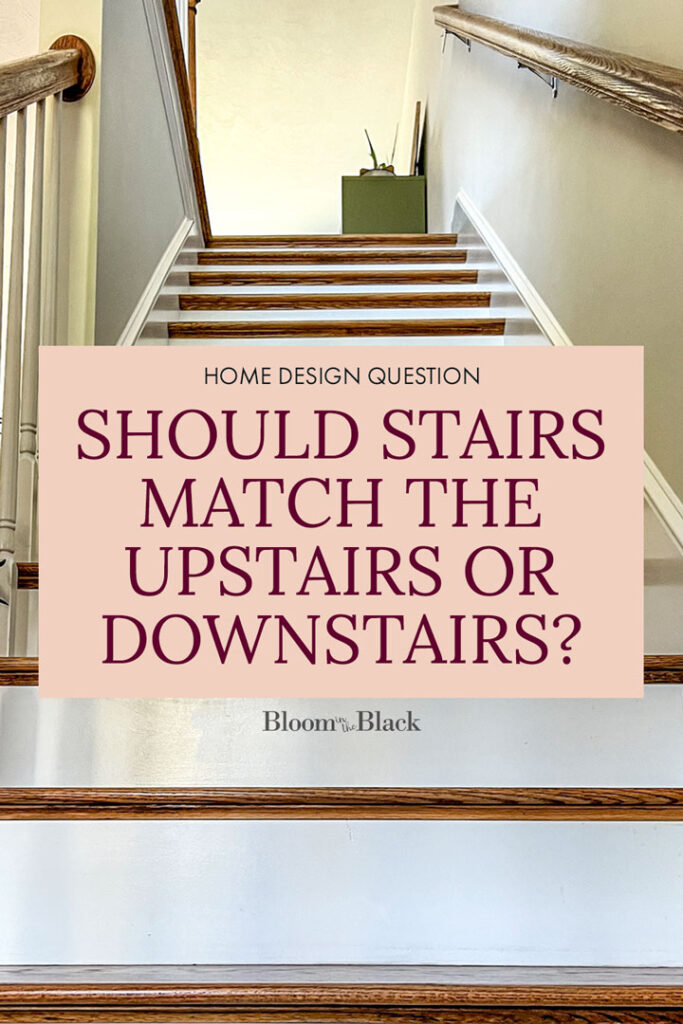Should Stairs Match the Upstairs or Downstairs?
Let’s start with the obvious: stairs serve as a transition space between two floors in your home. It’s tricky to design stairs that compliment both your downstairs and upstairs flooring. So how should you go about it?
Stairs should match both the upstairs and downstairs levels. If the flooring upstairs is entirely different from downstairs, find a middle ground that can act as a fitting transition. Determine which floors the stairs are most visible from to decide which type of flooring to feature more of.
In this article, we’ll talk about different ways to make the transition from your downstairs to your upstairs smoother by using clever tricks when the flooring on both levels matches, when they don’t, or when the flooring on both levels is made of entirely different materials.
Pin for later!

This post contains some affiliate links for your convenience. Click here to read my full disclosure policy. Thanks for supporting Bloom in the Black!
How To Match Your Stairs to Your Floor?
Match your upstairs and downstairs with your stairs by choosing the same type of flooring, so the transition will be smooth. However, if the floors are of different styles and designs, go for one that spells neutral territory. This allows you to incorporate elements from both floor levels for a more seamless look.
Same Flooring
If your upstairs and downstairs match, furnishing your stairs will be pretty straightforward. Use the same type of wood and the same shade of stain to make the transition between both levels seamless. If you want to add a bit of creativity and contrast, consider using a runner. Apart from its obvious aesthetic purposes, a runner will also add traction to your stairs, making them safer and easier to traverse.
Different Flooring
It starts getting tricky when your upstairs and downstairs flooring doesn’t match. For instance, if your downstairs is dark-stained oak and your upstairs is light-stained walnut, it can be complicated to decide which flooring to use for your stairs.
One trick is to determine at which level your stairs are more visible. Typically, you would see more of the stairs from downstairs than upstairs. Hence, the transition will seem smoother if you match your stairs to the downstairs flooring. If you have a landing, you can take it as an opportunity to switch to the upstairs flooring.
You can also coordinate elements from both levels into your stairs. For instance, you can use the same type and shade of wood from downstairs on each step, then use the same kind of wood and shade from upstairs on the risers. The contrasting elements will add character to your stairs and make the transition between levels smoother.
Same Carpeting
The same idea goes if both your downstairs and upstairs are carpeted. You can go for a shade or design that exactly matches both floor levels or the level from which your stairs are more visible.
For a bit of contrast, you can also opt for a similar carpet shade — one that is subtly darker or lighter. This way, your stairs will stand out and become more of a focal point in your home.
Different Carpeting
If the carpeting upstairs differs from your downstairs carpeting, search for a safe middle ground to start from. Look for a carpet design that blends both design elements, or go for a solid shade that complements the carpeting on both floors.
Striped or patterned carpets are an option to consider because you can seamlessly incorporate shades from your upstairs and downstairs carpeting. Furthermore, patterned carpets add contrast and a more stylish finish to the overall look. However, note that patterned carpeting only works if the carpets on both floors are of a solid color. If they have intricate designs, striped stairs will only be distracting and confusing.
Mixed Floors
It gets trickier. What happens when one level is carpeted and the other is wood? In this case, incorporate elements from both the upstairs and downstairs to provide a smooth transition when walking up or down your flight of stairs.
Using runners is an excellent idea because it will give you the best of both worlds. You enjoy the benefits of having added cushion and traction from carpets and the aesthetic value that wooden floors provide. You can use runners with self-adhesive features or, for a more distinct look, consider using stair rods. These will keep your runners in place and will add a designer touch to your stairs.
These gorgeous carpet runner stair rods with knurled caps (available on Etsy) are made of solid brass and will give your stairs a more elegant look. The rods come in four colors so they’re well-suited to match any stair runner you choose.
Final Thoughts
Stairs should provide a seamless transition between the upstairs and downstairs in your home. To do so, combine elements from each level or focus on the details on the level from which your stairs are more visible.
Do not hesitate to unleash your creative side when designing your stairs. Incorporate hand railings, stair treads, runners, different carpet designs, and varying wood stains to give your stars a distinct look. These can also be designed to make your stairs safer for everyone in the family.
